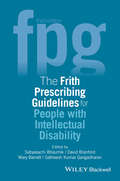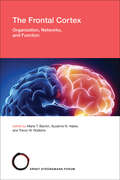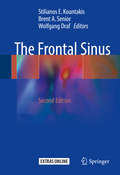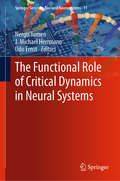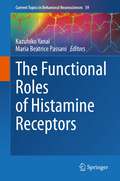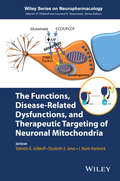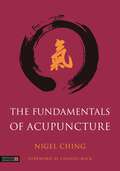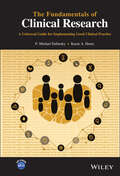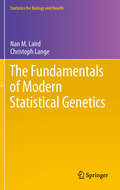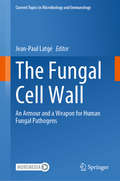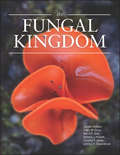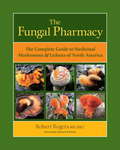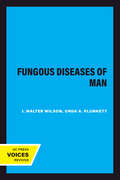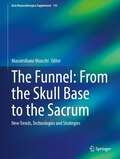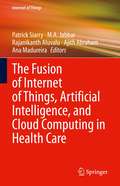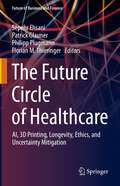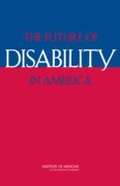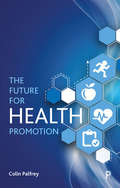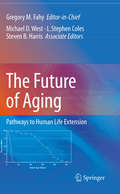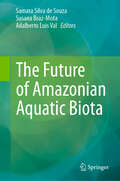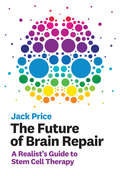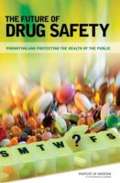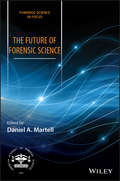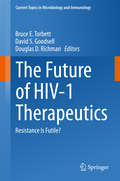- Table View
- List View
The Frith Prescribing Guidelines for People with Intellectual Disability
by David Branford Sabyasachi Bhaumik Mary Barrett Satheesh Kumar GangadharanThe Frith Prescribing Guidelines for People with Intellectual Disability provides comprehensive guidance on prescribing for patients with intellectual disability as well as general information on the clinical care of this important population. The guidelines have been conceived and developed by clinicians working in intellectual disability services. They are based on both the latest evidence and expert opinion to provide a consensus approach to prescribing as part of a holistic package of care, and include numerous case examples and scenarios. New to this third edition is improved coverage of children and the role of primary care teams. The Frith Prescribing Guidelines for People with Intellectual Disability remains a practical guide for busy clinicians and a valuable reference for all primary and secondary health care professionals caring for people with intellectual disability.
The Frontal Cortex: Organization, Networks, and Function (Strüngmann Forum Reports #35)
by Trevor W. Robbins Marie T. Banich Suzanne N. HaberAn in-depth investigation of the structure, neuronal mechanisms, and computations of the frontal lobe that enable higher-level thought.Experts from neurobiology, neuroanatomy, evolutionary biology, cognitive neuroscience, computational neuroscience, and clinical science examine how the neuronal structure of the frontal lobes enables unique aspects of higher-level thought. Implications for understanding disrupted function in neurological and psychiatric disorders, as well as societal issues, such as volitional control of behavior and educational practice, are also considered.
The Frontal Sinus
by Stilianos E. Kountakis Brent A. Senior Wolfgang DrafThis is the only book dedicated solely to frontal sinus disorders. It is a richly illustrated and comprehensive mine of information on the anatomy and management of these disorders. This updated second edition offers much new information. Additional topics include balloon dilation, frontal surgery as part of skull base surgery, and advances in endoscopic techniques and tools that have occurred since 2004 and have made open osteoplastic procedures almost obsolete. The anatomy and surgery of the supraorbital ethmoid cell and its significance in the pathology of frontal sinus disease are also covered. Throughout the book, particularly important areas of text are highlighted and core messages, emphasized. Videos of described procedures are available online.
The Functional Role of Critical Dynamics in Neural Systems (Springer Series on Bio- and Neurosystems #11)
by Nergis Tomen J. Michael Herrmann Udo ErnstThis book offers a timely overview of theories and methods developed by an authoritative group of researchers to understand the link between criticality and brain functioning. Cortical information processing in particular and brain function in general rely heavily on the collective dynamics of neurons and networks distributed over many brain areas. A key concept for characterizing and understanding brain dynamics is the idea that networks operate near a critical state, which offers several potential benefits for computation and information processing. However, there is still a large gap between research on criticality and understanding brain function. For example, cortical networks are not homogeneous but highly structured, they are not in a state of spontaneous activation but strongly driven by changing external stimuli, and they process information with respect to behavioral goals. So far the questions relating to how critical dynamics may support computation in this complex setting, and whether they can outperform other information processing schemes remain open. Based on the workshop “Dynamical Network States, Criticality and Cortical Function", held in March 2017 at the Hanse Institute for Advanced Studies (HWK) in Delmenhorst, Germany, the book provides readers with extensive information on these topics, as well as tools and ideas to answer the above-mentioned questions. It is meant for physicists, computational and systems neuroscientists, and biologists.
The Functional Roles of Histamine Receptors (Current Topics in Behavioral Neurosciences #59)
by Maria Beatrice Passani Kazuhiko YanaiResearch in the field of histamine receptors over the past 100 years went hand-in-hand with the development of modern pharmacology. Advances in histamine research led by outstanding scientists was so incisive that the clinical approach to treat allergies and gastrointestinal ailments was revolutionized. The pharmacological treatment of peptic ulcer and gastroesophageal reflux was indeed a revolution, as it ended the surgical intervention. Interest in histamine pharmacology was resurrected by the discovery of another histamine receptor, number 4, using genomics-based reverse pharmacological approaches for screening orphan GPCRs. This receptor is preferentially expressed by immune cells and its discovery raised hopes for its translational exploitation as a new therapeutic target for unmet medical needs ranging from asthma to cancer. However, several drawbacks emerged and dramatically slowed down research in the field. A better understanding of receptor intra-and interspecies heterogeneity will certainly improve and accelerate the translation of experimental data into clinical practice. Also, the plethora of data on brain histamine is hinting at a fundamental role of this system as a hub that receives internal and peripheral stimuli to allocate the necessary excitation to specific brain circuits that preside the appropriate behavioral responses. The development of new histaminergic ligands is an ongoing process that constantly provide new preclinical tools. The aim of this book is to cover the most important aspects of histamine receptor function and pharmacology in the central nervous system and to provide a comprehensive overview of the preclinical and clinical advances made in recent decades and the exciting prospects for the future. It highlights the clinical areas where there is a great need for new therapeutic approaches and where novel histaminergic agents may be useful for personalized medicine.
The Functions, Disease-Related Dysfunctions, and Therapeutic Targeting of Neuronal Mitochondria
by Valentin K. Gribkoff J. Marie Hardwick Elizabeth A. JonasThis book presents advances in the field of neuronal mitochondria - functions, relation to therapeutics, and pharmacology. For scientists and researchers in both industry and academia, this book provides detailed discussion, examples, and approaches, to illustrate the potential of mitochondria as therapeutic targets for neuronal diseases. * Helps readers understand the regulation of mitochondrial cellular processes, such as substrate metabolism, energy production, and programmed versus sporadic cell death * Offers insights on the development of strategies for targeted therapeutic approaches and potential personalized treatments * Includes examples of mitochondrial drugs, development, and mitochondria-targeted approaches for more efficient treatment methods and further developments in the field * Covers the model systems and approaches needed for the development of new drugs for the central nervous system to provide potential modern therapeutics for neurodegenerative disorders
The Fundamentals of Acupuncture
by Charles Buck Nigel ChingThis accessible textbook clearly explains the basic foundations and principles of acupuncture and Chinese Medicine. With over 70 illustrations, it covers the theories of yin and yang, the five phases, the physiology of the body, the internal organs, the channel system, acupuncture point categories, the point functions and indications, needling techniques and aetiological factors. Authoritative, yet readable, this is a vital addition to the shelves of all students of Chinese medicine.
The Fundamentals of Clinical Research: A Universal Guide for Implementing Good Clinical Practice
by P. Michael Dubinsky Karen A. HenryThis book focuses on the practical application of good clinical practice (GCP) fundamentals and provides insight into roles and responsibilities included in planning, executing, and analyzing clinical trials. The authors describe the design of quality into clinical trial planning and the application of regulatory, scientific, administrative, business, and ethical considerations. Describes the design of quality into the clinical trial planning Has end-of-chapter questions and answers to check learning and comprehension Includes charts that visually summarize the content and allow readers to cross-reference details in relevant chapters Offers a companion website containing supplemental training resources
The Fundamentals of Modern Statistical Genetics
by Nan M. Laird Christoph LangeThis book covers the statistical models and methods that are used to understand human genetics, following the historical and recent developments of human genetics. Starting with Mendel's first experiments to genome-wide association studies, the book describes how genetic information can be incorporated into statistical models to discover disease genes. All commonly used approaches in statistical genetics (e.g. aggregation analysis, segregation, linkage analysis, etc), are used, but the focus of the book is modern approaches to association analysis. Numerous examples illustrate key points throughout the text, both of Mendelian and complex genetic disorders. The intended audience is statisticians, biostatisticians, epidemiologists and quantitatively- oriented geneticists and health scientists wanting to learn about statistical methods for genetic analysis, whether to better analyze genetic data, or to pursue research in methodology. A background in intermediate level statistical methods is required. The authors include few mathematical derivations, and the exercises provide problems for students with a broad range of skill levels. No background in genetics is assumed.
The Fungal Cell Wall: An Armour and a Weapon for Human Fungal Pathogens (Current Topics in Microbiology and Immunology #425)
by Jean-Paul LatgéThis book illustrates, that the fungal cell wall is critical for the biology and ecology of all fungi and especially for human fungal pathogens. Readers will learn, that the composition of the fungal cell wall is a unique structure, which cannot be found in the human host. Consequently, the chapters outline, how the immune systems of both animals and humans have evolved to recognize conserved and unique elements of the fungal cell wall. As an application example, the authors also show, that the three-dimensional structures of the cell wall are excellent targets for the development of antifungal agents and chemotherapeutic strategies. With the combination of biological findings and medical outlooks, this volume is a fascinating read for scientists, clinicians and biomedical students.
The Fungal Kingdom (ASM Books #35)
by Joseph Heitman Barbara J. Howlett Pedro W. Crous Eva H. Stukenbrock Timothy Yong James Neil A. GowFungi research and knowledge grew rapidly following recent advances in genetics and genomics. This book synthesizes new knowledge with existing information to stimulate new scientific questions and propel fungal scientists on to the next stages of research. This book is a comprehensive guide on fungi, environmental sensing, genetics, genomics, interactions with microbes, plants, insects, and humans, technological applications, and natural product development.
The Fungal Pharmacy
by Robert Rogers Solomon P. WasserIn The Fungal Pharmacy, noted herbalist Robert Rogers introduces readers to more than 300 species of medicinal mushrooms and lichens found in North America. These fungi, Rogers explains, have the capacity to heal both the body and, through the process of myco-remediation, the planet itself. Throughout the book, he documents their success in optimizing the immune system and treating a wide range of acute and chronic diseases, including cardiovascular, respiratory, and liver problems, blood sugar disorders, cancer, and obesity.Entries discuss the mushroom or lichen's medicinal traits and properties, including active chemical components, preparation methods (including extracts, essences, and essential oils), and historical as well as modern-day usage. Two hundred full-color photos and thorough descriptions make identification easy for the reader. Rogers also delves into the cultural, religious, and literary significance of each mushroom, featuring fascinating tidbits about each one's etymology and history.
The Fungous Diseases of Man
by J. Walter Wilson Orda A. PlunkettThis title is part of UC Press's Voices Revived program, which commemorates University of California Press’s mission to seek out and cultivate the brightest minds and give them voice, reach, and impact. Drawing on a backlist dating to 1893, Voices Revived makes high-quality, peer-reviewed scholarship accessible once again using print-on-demand technology. This title was originally published in 1965.
The Funnel: New Trends, Technologies and Strategies (Acta Neurochirurgica Supplement #135)
by Massimiliano VisocchiSkull-base surgery is a minimally invasive endoscopic procedure, which involves the surgeon inserting instruments through the natural openings in the skull—the nose or mouth—or by making a small hole just above the eyebrow. This type of surgery requires a team of specialists, which may include ENT (ear, nose, and throat), maxillofacial and neurosurgeons, as well as radiologists. The craniovertebral junction (CVJ) has a unique anatomical bone and neurovascular structure, which not only separates the subaxial cervical spine but also provides a special cranial flexion, extension and axial rotation pattern. As such, a sound knowledge of the basic principles of spine instrumentation and the region’s kinematics are essential when it comes to strategic preoperative planning. Skull-base, craniovertebral junction, spine demolitive and reconstructive surgery, neuromodulation, bioengineering and transplantation are recent tools used to improve reconstruction, restoration and rehabilitation – three key words central to the core aim of the Neurorehabilitation and Reconstruction Committee of the WFNS, which is to promte mechanical morphological and functional restoration.
The Fusion of Internet of Things, Artificial Intelligence, and Cloud Computing in Health Care (Internet of Things)
by Ajith Abraham Patrick Siarry Ana Madureira M. A. Jabbar Rajanikanth AluvaluThis book reviews the convergence technologies like cloud computing, artificial intelligence (AI) and Internet of Things (IoT) in healthcare and how they can help all stakeholders in the healthcare sector. The book is a proficient guide on the relationship between AI, IoT and healthcare and gives examples into how IoT is changing all aspects of the healthcare industry. Topics include remote patient monitoring, the telemedicine ecosystem, pattern imaging analytics using AI, disease identification and diagnosis using AI, robotic surgery, prediction of epidemic outbreaks, and more. The contributors include applications and case studies across all areas of computational intelligence in healthcare data. The authors also include workflow in IoT-enabled healthcare technologies and explore privacy and security issues in healthcare-based IoT.
The Future Circle of Healthcare: AI, 3D Printing, Longevity, Ethics, and Uncertainty Mitigation (Future of Business and Finance)
by Philipp Plugmann Patrick Glauner Sepehr Ehsani Florian M. ThieringerThe past decade has brought to the fore the critical need to constantly envision and consider various scenarios where ongoing trends and sudden changes could together alter the provision of healthcare and the direction of medical research. This book brings together scholars whose areas of expertise represent different themes that are essential to understanding how healthcare might change and evolve over the next decade. What lessons can one take away from current and past developments? The themes explored by the book rest on four pillars. The first is the rapid pace and ubiquity of technological advances in areas such as artificial intelligence, machine learning, additive manufacturing and wearable electronics. The second pillar concerns healthy aging, longevity and the management of chronic diseases. The third is the imperative to remain cognizant of the ethical dimensions of medical decisions, adapting bioethics to ongoing changes in healthcare provision. Finally, the fourth pillar relates to how uncertainty in different domains of medical knowledge can be mitigated and translated into clinical practice. For example, how should uncertainty with the results of clinical trials for a new treatment be dealt with? What cost-benefit analyses would be most appropriate for the situation? Chapter authors identify respective challenges and promising opportunities, discussing how these could contribute to envisioning the future scope of healthcare when it comes to providing medical, economic and ethical values to human societies.Chapters 1, 4, 12, and 20 are available open access under a Creative Commons Attribution 4.0 International License via link.springer.com.
The Future Of Disability In America
by Institute of Medicine of the National AcademiesThe future of disability in America will depend on how well the U.S. prepares for and manages the demographic, fiscal, and technological developments that will unfold during the next two to three decades. Building upon two prior studies from the Institute of Medicine (the 1991 Institute of Medicine's report Disability in America and the 1997 report Enabling America), The Future of Disability in America examines both progress and concerns about continuing barriers that limit the independence, productivity, and participation in community life of people with disabilities. This book offers a comprehensive look at a wide range of issues, including the prevalence of disability across the lifespan; disability trends the role of assistive technology; barriers posed by health care and other facilities with inaccessible buildings, equipment, and information formats; the needs of young people moving from pediatric to adult health care and of adults experiencing premature aging and secondary health problems; selected issues in health care financing (e.g., risk adjusting payments to health plans, coverage of assistive technology); and the organizing and financing of disability-related research. The Future of Disability in America is an assessment of both principles and scientific evidence for disability policies and services. This book's recommendations propose steps to eliminate barriers and strengthen the evidence base for future public and private actions to reduce the impact of disability on individuals, families, and society.
The Future Of Healthcare: It's Health, Then Care
by Frances J. TuriscoHealthcare is ripe for disruptive innovation. CSC takes a holistic view of healthcare, with the patient at the center, and identifies 5 trends that will re-shape the industry. Healthcare is moving from a care-first to a wellness-first perspective via the efforts and technologies in these trends: E-Power to the Patient - Patients take on a larger, more active role in managing their wellness and health. Earlier Detection - Earlier detection maximizes options for successful treatment, leading to a speedier return to good health. High-Tech Healing - New technologies can significantly boost outcomes and quality of life. Resources: More, but Different - Solving the healthcare resource puzzle requires new players and new care models. Global Healthcare Ecosystem Emerges - More information, more connected, leads to better care and better research. This report targets patients, providers, healthcare businesses, technology companies and industry gurus. Learn how you can be part of the change.
The Future for Health Promotion
by Colin PalfreyDoes health promotion have a lasting and positive effect on people? With mounting pressure to reduce costs to the NHS and increasing scepticism of the so-called nanny state, health promotion initiatives are increasingly being criticised as costly and ineffective, with many arguing that health inequalities can only be reduced through radical political and economic change. This book examines the methods used to evaluate the value of health promotion projects and determines whether attempts to change people’s lifestyles have proved successful. Taking into account the practical and ethical issues involved in deciding the appropriate approach to take in efforts to reduce health inequalities, the book assesses what might be the best path forward for health promotion.
The Future of Aging
by Gregory M. Fahy L. Steven Coles Michael D West Stephen B. HarrisJust as the health costs of aging threaten to bankrupt developed countries, this book makes the scientific case that a biological "bailout" could be on the way, and that human aging can be different in the future than it is today. Here 40 authors argue how our improving understanding of the biology of aging and selected technologies should enable the successful use of many different and complementary methods for ameliorating aging, and why such interventions are appropriate based on our current historical, anthropological, philosophical, ethical, evolutionary, and biological context. Challenging concepts are presented together with in-depth reviews and paradigm-breaking proposals that collectively illustrate the potential for changing aging as never before. The proposals extend from today to a future many decades from now in which the control of aging may become effectively complete. Examples include sirtuin-modulating pills, new concepts for attacking cardiovascular disease and cancer, mitochondrial rejuvenation, stem cell therapies and regeneration, tissue reconstruction, telomere maintenance, prevention of immunosenescence, extracellular rejuvenation, artificial DNA repair, and full deployment of nanotechnology. The Future of Aging will make you think about aging differently and is a challenge to all of us to open our eyes to the future therapeutic potential of biogerontology.
The Future of Amazonian Aquatic Biota
by Samara Silva de Souza Susana Braz-Mota Adalberto Luis ValThe aquatic habitats of the Amazon region are subject to natural daily and seasonal variations in the physico-chemical properties of the water. The organisms that inhabit these habitats have developed adaptations to cope with these natural events. However, human-induced environmental changes are threatening ecosystems and affecting biodiversity at all levels of biological organization by causing drastic changes in climatic conditions in a shorter period of time, without giving organisms time to adapt. In this sense, the book addresses the future of aquatic organisms in the Amazon, including bacterial symbionts, insects, crustaceans, fish, plants, and amphibians, and provides an overview of what the future of biodiversity in the Amazon will look like, both in terms of organisms' adaptations to natural changes and in terms of vulnerability and responses to human impacts, highlighting possible mechanisms to minimize the expected impacts. The book also provides a brief overview of the risks that climate change poses to livestock, strategies for the sustainable use of species in the Amazon region and the impact of climate change on fish diseases.
The Future of Brain Repair: A Realist's Guide to Stem Cell Therapy (The\mit Press Ser.)
by Jack PriceA scientist assesses the potential of stem cell therapies for treating such brain disorders as stroke, Alzheimer's disease, and Parkinson's disease.Stem cell therapies are the subject of enormous hype, endowed by the media with almost magical qualities and imagined by the public to bring about miracle cures. Stem cells have the potential to generate new cells of different types, and have been shown to do so in certain cases. Could stem cell transplants repair the damaged brain? In this book, neurobiologist Jack Price assesses the potential of stem cell therapies to treat such brain disorders as stroke, Alzheimer's disease, Parkinson's disease, and spinal cord injuries.Certainly brain disorders are in need of effective treatments. These disorders don't just kill, they disable, and conventional drug therapies have not had much success in treating them. Price explains that repairing the human brain is difficult, largely because of its structural, functional, and developmental complexity. He examines the self-repairing capacity of blood and gut cells—and the lack of such capacity in the brain; describes the limitations of early brain stem cell therapies for neurodegenerative disorders; and discusses current clinical trials that may lead to the first licensed stem cell therapies for stroke, Parkinson's and macular degeneration. And he describes the real promise of pluripotential stem cells, which can make all the cell types that constitute the body. New technologies, Price reports, challenge the very notion of cell transplantation, instead seeking to convince the brain itself to manufacture the new cells it needs. Could this be the true future of brain repair?
The Future of Drug Safety: Promoting and Protecting the Health of the Public
by Institute of Medicine of the National AcademiesIn the wake of publicity and congressional attention to drug safety issues, the Food and Drug Administration (FDA) requested the Institute of Medicine assess the drug safety system. The committee reported that a lack of clear regulatory authority, chronic underfunding, organizational problems, and a scarcity of post-approval data about drug's risks and benefits have hampered the FDA's ability to evaluate and address the safety of prescription drugs after they have reached the market. Noting that resources and therefore efforts to monitor medication's risk-benefit profiles taper off after approval, The Future of Drug Safety offers a broad set of recommendations to ensure that consideration of safety extends from before product approval through the entire time the product is marketed and used.
The Future of Forensic Science: Current Research And Practice Leading To Future Opportunities (Forensic Science in Focus)
by Douglas H. Ubelaker Daniel A. MartellOffers a diverse, interdisciplinary, and eye-opening view of the future direction of forensic science This one-of-a-kind book is a collection of content from the Past and Current Presidents of the American Academy of Forensic Sciences—providing readers with all of their forensic science experience, knowledge, insight, and wisdom. It envisions where forensic science will be a decade from now and the impact of these emerging advances on the law (along with our place in it), emphasizing theoretical advances, innovative leads from the laboratory, and emerging technologies. Filled with information from some of the greatest forensic minds of their generation, The Future of Forensic Science covers all of the eleven sections that comprise the AAFS. It discusses new directions in forensic anthropology, and looks at the future of such disciplines as criminalistics, forensic engineering science, forensic psychiatry and behavioral science, forensic toxicology, and forensic document examination. It also touches on the current and future state of digital and multimedia sciences. Contains contributions from an eminent group of forensic science experts Presents a valuable repository of forensic science experience, knowledge, insight, and wisdom Offers an insightful interdisciplinary look at the future of forensic science and how it is changing forensic science for the better Timed to coincide with the NIST forensic science initiative and the OSAC process The Future of Forensic Science is a must-have book for practicing forensic science professionals, academics, and advanced undergraduate and graduate students in forensic science. This book is published as part of the AAFS series ‘Forensic Science in Focus’.
The Future of HIV-1 Therapeutics
by David S. Goodsell Bruce E. Torbett Douglas D. RichmanThis volume thoroughly covers HIV-1 antiretrovirals currently in clinical use, together with their advantages and limitations. HIV-1 inhibitor resistance is discussed in detail, and critical assessments as to what will be required of future antiretrovirals in order to halt viral replication, reduce viral resistance, and alter the state of viral latency are presented. Experts at the forefront of HIV-1 research provide overviews of approaches from the fields of virology, chemical biology and structural biology for obtaining small molecule inhibitors that target viral regulatory and structural components at multiple points in the viral lifecycle. The individual chapters will appeal to scientists and clinicians alike.
